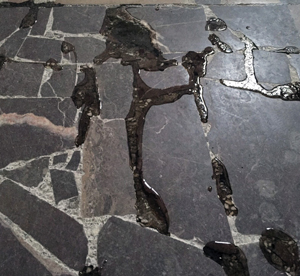RENNOVATION OF FLOORS

There are several easy ways how to fill in the orifices. The stonemasons have had, for several years, at their disposal so called “hot” cements. They are distributed in several basic colours and used for filling out of small orifices in stone.
They will come handy especially in emergency situations. Although, they are not suitable for professional use. They can be used in places that are difficult to access, aside from larger stress in consequence of high traffic – such as close to walls, in corners and in alleyways. These types of cement cannot be sanded down and they stay porous forever which encourages dirt deposition. With a little smile, we can say that the limited choice of colours is, actually, not bad because after several days, the cement will turn black anyways. It does not matter so much in the case of multi-coloured surface. This type of cement can be successfully used on vertical surfaces: walls, columns, pillars etc. “Hot” cement needs to be first warmed up to a high temperature and then used only to fill out the defect. After that, it needs to be sanded. If you do not want to sad it down, you can even the surface with a sharp scraper. If there are many smaller defects on the surface of the floor, you can use an epoxide resin to fill them out. You can use a resin with longer lasting drying and in this way gain time for proper spreading of the resin around larger area. Also, a preparation on polymer basis which will seal of little orifices efficiently.
The above stated methods of repairing can be easily applied on marble as well as granite surfaces. They are also suitable for terraca repairs.

It sometimes happens that stone tiles get loose, and they need to be re-attached. For this purpose, you need to take them out, clean the surface and then re-attach them. There are many agents for this purpose, including the same type of cement that is used for filling out of defects. It can also be easily used to fill out the joints between slabs. The choice of the agent depends on particular conditions, and it requires certain specific experience.
If the renovated floor has got joints between the tiles you need to fill them out or renovate them before any larger works. An old joint or its part, especially when visibly damaged, needs to be removed. A mini grinder, grout float, or regular scraping tool. Then, fill the joint out, preferably with an epoxide. After you are done with the removal of blemishes, you can start grinding the surface. At this phase, the material on any of the freshly filled spaces can easily break off. There can also appear new spaces as a consequence of breaking off of weaker rock elements. In this case, you need to clean the gaps again and repeat the surface repair. If the stone chips off in the final phase of grinding, you can use also a “hot cement”. There will not be any need to re-grind any part of the floor after that. If hot cements cannot be used for any reason, an epoxide or polyester based cement can also be used, and that particular stone part can be re-sanded. So much for an introduction. We will try to bring a more detailed description of concrete cases in the following articles. There will also be instructions on which agents and how to use them correctly.
Source: Kurier kamieniarski
Author: Artur Janus | Published: 21. 12. 2020
